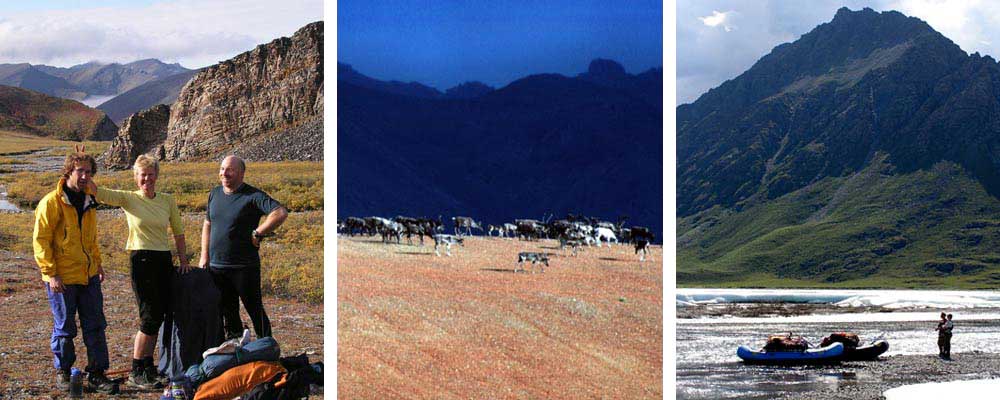
Resources
Links
State and Federal
- Alaska Geographic: alaskageographic.org
- Alaska Public Lands Information Center: alaskacenters.gov
- Arctic National Wildlife Refuge: fws.gov/alaska/nwr/arctic
- Gates of the Arctic National Park: nps.gov/gaar/index.htm
- State of Alaska Info: alaska.gov/visitorHome.html
- US Forest Service Information Center: www.fs.usda.gov/r10
Weather
- Alaska Climate Research Center: climate.gi.alaska.edu
- Arctic Village: weather.com/weather/local/USAK0021
- Bettles: weather.com/weather/today/Bettles+AK+USAK0029:1:US
- Whittier: whittierak.yukontel.com
Conservation and Environment
- Alaska Center for the Environment: akcenter.org
- Alaska Coalition: alaskacoalition.org
- Arctic Refuge Friends: alaskarefugefriends.org
- Northern Alaska Environmental Center: northern.org
Outdoor Equipment
- Alaska Mountaineering and Hiking: alaskamountaineering.com
- Campmor: campmor.com
- Cocoon (Design Salt): cocoon.at
- Kelty: kelty.com
- Mountain Gear: mgear.com
- Serenity Shelters: serenityshelter.com
- Northwest River Supply: nrsweb.com
- Patagonia: patagonia.com
- REI: rei.com
- Seaward Kayaks: seawardkayaks.com
- Trails Illustrated: shop.nationalgeographic.com
Miscellaneous
- Travelex Travel Insurance: www.travelexinsurance.com
- Switchback Travel: www.switchbacktravel.com
Maps: an overview
It is interesting to note and reflect on how large the state of Alaska really is. Alaska has a land mass of 591,004 sq. miles as compared to California which has 158,709 sq. miles and Texas which has 266,807. Alaska has more coastline than the sum of the lower contiguous states. Click on the maps below to enlarge and explore.
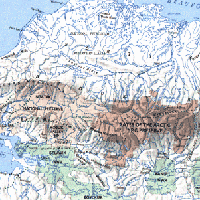
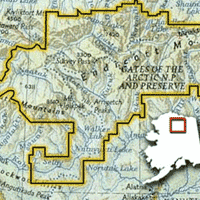
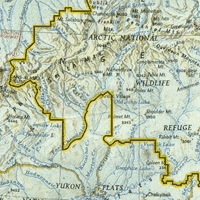
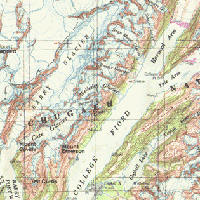
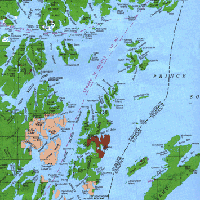
What makes the Arctic Refuge special?

The vast majority of mankind has developed between the middle latitudes of both hemispheres on our planet. This is nurturing and predictable habitat for humans. Days and nights shift here like a heartbeat and we have become very comfortable and successful here. The sun comes up, we become active and when darkness returns, we grow quiet. This circadian rhythm is hardwired in our motherboard. Subconsciously, we depend on it to define our being. Because of Earth's tilted axis, the polar regions are more reckless and unsettled. These regions binge wildly on daylight during the summer and fast in 24 hour darkness during the winter. This is the signature quality that is so captivating about the Arctic. Complete and uninterrupted daylight is completely and utterly fascinating and at the same time equally disturbing. Its brilliance stirs us and our imagination and keeps us perpetually interested in our surroundings. In fact the quality of this light reaches its most pleasing when we should be most inactive (the middle of the faux night). We are not the only ones that are stirred by this daylight however. And this leads us to the Arctic Refuge in particular. The Refuge is far enough north to enjoy these delightful swings of perpetual daylight and far south enough to do something about it. May brings the 24 hour days and after a month of sun. The shackles of winter have loosen up and countless numbers of plants emerge and spread a rainbow of colorful blooms in every nook and cranny. Unimaginably, birds from 4 continents fly here specifically to raise young. How on Earth did they find this place? But their round the clock songs of celebration reenforce the wonder and enchantment of this place. Out from under the snow and up from the boreal forests of the Brooks Range's southern side mammals pour in to this land where the energy switch has been flipped to all day on and also proceed the upbringing of their youngsters.
The Refuge is distinct from any other part of the Alaskan Arctic by its compression of habitats. 50 miles south of land's end stand the tallest mountain in the entire Brooks Range. 50 miles is a very comprehendible figure. It does not take much technology or super human powers to travel 50 miles. In that short distance, the Refuge shuffles through a menagerie of habitats transforming into each other seamlessly yet sensationally. From a perch in the northern foothills, one can scan south and see the glacial clad steeps. Revolving to the north the hills lower and loose their snow white caps and trade them for bare rock and perhaps for sheep. The valleys that separate these great peaks flow directly north and cradle other life in their tundra and shrub basins. Moose, bears and wolves emerge when you focus. Your perch of the foothills is shared by large cliff nesting birds of prey and several flowers wavering in the breeze. Past the foothills the coastal plain rolls and ungulates in subtle forms like a pile of light summer clothes fresh from the dryer. Here one sees the seas of caribou or bands of muskox. At the edge of the tundra, the ocean and the continent collide in a disconsonate tug of turf war. Rivers spread out in wide deltas, barrier reefs are stretched out in a thinly veiled defense and once the ice retreats waves constantly crash upon them trying to erode and reposes this dmz. Far off on the horizon, due north, you see the polar ice pack and by mischievous warpings of atmospheric slights of hand it appears to tower to the sky in great sheer bluffs like the steeps directly behind you now.
It is a good thing that there are days that are 24 hours long, for it can easily take that long to digest such a panorama. When you have settled into this country, your pace slows and your senses become infinitely more acute. In the Arctic Refuge you need not go anywhere to be overwhelmed by sight and sound and on a good day, the memories of a good day will eclipse any viewing experience you have ever witnessed. After 20 years, I have a good idea of when and where these good days roll and I can't imagine being anywhere else on the planet during them - these days under the midnight sun are PRICELESS!
There truly is no place on Earth like it and with sound judgment and good fortune it will stay just as it is, wonderfully wild and frenetically furtive inspite of us all. I hope that the golden plover can always sing his celebratory song all night long upon his annual return after thousands of miles of open ocean flight to this one great place.
